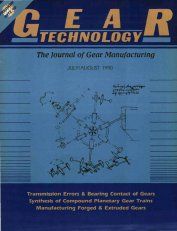Traditional methods of manufacturing precision gears usually employ either hobbing or shaper cutting. Both of these processes rely upon generating the conjugate tooth form by moving the work-piece in a precise relation to the tool. Recently, attention has been given to forming gear teeth in a single step. Advantages to such a process include reduced production time, material savings, and improved performance characteristics. Drawbacks include complicated tool designs, non-uniformity of gears produced throughout the life of the tooling, and lengthy development times.
